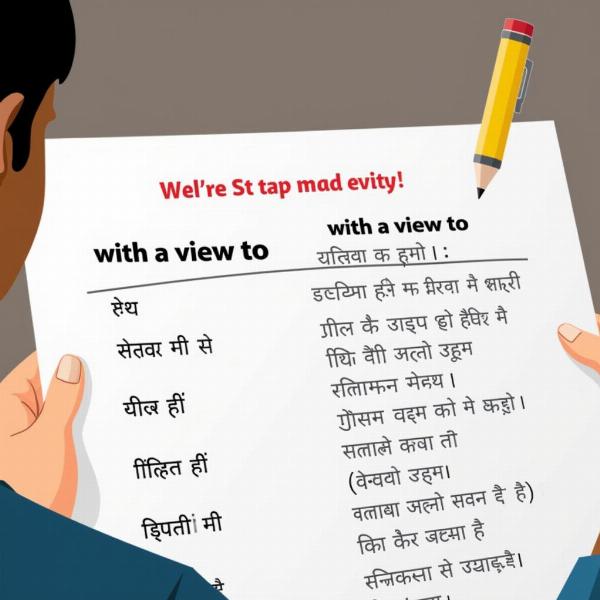Understanding the meaning of “with a view to” in Hindi is crucial for accurate translation and communication. This phrase, commonly used in English to express purpose or intention, doesn’t have a single, perfect equivalent in Hindi. Its translation depends heavily on the context. This article will explore various ways to express “with a view to” in Hindi, providing examples and explanations to ensure you choose the most appropriate translation every time.
Decoding “With a View To” in Different Contexts
The English phrase “with a view to” signifies an intention or purpose behind an action. It implies a future goal that motivates the present action. In Hindi, we can capture this meaning using several different words and phrases, each with its own nuance.
Using the Infinitive Verb Form
One common way to translate “with a view to” is by using the infinitive form of the Hindi verb. This is particularly useful when the intended action is directly related to the main verb. For example:
- “He went to the library with a view to studying.” can be translated as “वह पढ़ने के लिए पुस्तकालय गया” (vah padhne ke liye pustakalaya gaya). Here, “padhne ke liye” (for studying) uses the infinitive form of “padhna” (to study).
Utilizing “Ke Uddeshya Se” (के उद्देश्य से)
Another accurate translation of “with a view to” is “ke uddeshya se” (के उद्देश्य से), which means “with the objective of” or “for the purpose of.” This phrase is more formal and emphasizes the specific goal.
- “She saved money with a view to buying a house.” translates to “उसने घर खरीदने के उद्देश्य से पैसे बचाए” (usne ghar kharidne ke uddeshya se paise bachae).
Exploring Other Options: “Taaki” (ताकि), “Isliye” (इसलिए), “Ke Liye” (के लिए)
Depending on the context, other words like “taaki” (ताकि – so that), “isliye” (इसलिए – therefore), and “ke liye” (के लिए – for) can also effectively convey the meaning of “with a view to.” These options are often used in less formal settings.
- “He worked hard with a view to passing the exam.” can be translated as “वह परीक्षा पास करने के लिए कड़ी मेहनत करता रहा” (vah pariksha pass karne ke liye kadi mehnat karta raha) or “वह परीक्षा पास करे, ताकि उसने कड़ी मेहनत की” (vah pariksha pass kare, taaki usne kadi mehnat ki).
 Translating "With a View To"
Translating "With a View To"
Mastering the Nuances: Choosing the Right Hindi Equivalent
While the options above all convey the general meaning of “with a view to,” selecting the most appropriate translation depends heavily on the specific context and the level of formality required.
Formal vs. Informal Language
For formal documents or official communication, “ke uddeshya se” is often preferred. In casual conversation, “ke liye” or “taaki” may be more suitable.
Emphasis on the Goal
If the emphasis is on the ultimate goal, “ke uddeshya se” clearly highlights the purpose. If the focus is more on the action itself, the infinitive form or “ke liye” might be better choices.
Examples and Practical Applications
Let’s look at some more examples to solidify our understanding:
- “They invested in the company with a view to earning profits.” – “उन्होंने मुनाफा कमाने के उद्देश्य से कंपनी में निवेश किया” (unhone munafa kamane ke uddeshya se company mein nivesh kiya).
- “He started exercising with a view to improving his health.” – “वह अपने स्वास्थ्य में सुधार लाने के लिए व्यायाम करने लगा” (vah apne swasthya mein sudhar lane ke liye vyayam karne laga).
Conclusion
Understanding the various ways to translate “with a view to” in Hindi is essential for clear and effective communication. By considering the context and nuances of each option, you can ensure your translation accurately reflects the intended meaning. Remember to choose the most appropriate Hindi equivalent based on the level of formality and the emphasis you want to convey. This will allow you to communicate your intentions precisely and avoid any misunderstandings.
FAQ
-
What is the most common Hindi translation for “with a view to”? While there isn’t a single “most common” translation, “ke uddeshya se” and “ke liye” are frequently used.
-
Can I use “taaki” in formal writing? While “taaki” can be used, “ke uddeshya se” is generally preferred for formal settings.
-
Is there a difference between “ke liye” and “ke uddeshya se”? “Ke uddeshya se” emphasizes the purpose or objective more strongly than “ke liye.”
-
What if I’m unsure which translation to use? Consider the context and level of formality. If still uncertain, consult a Hindi language expert.
-
Where can I find more examples of “with a view to” in Hindi? Online dictionaries and language learning resources can provide further examples.
Related Articles
- marna meaning in hindi
- love bites meaning in hindi
- swadha meaning in hindi
- regularity meaning in hindi
Meaning-Hindi.in is your trusted partner for accurate and culturally sensitive Hindi translation services. We specialize in business, legal, technical, website localization, educational, and specialized translations, offering fast and reliable service. Contact us for all your Hindi translation needs at [email protected] or +91 11-4502-7584. Meaning-Hindi.in ensures your message is conveyed effectively in the vibrant tapestry of the Hindi language.